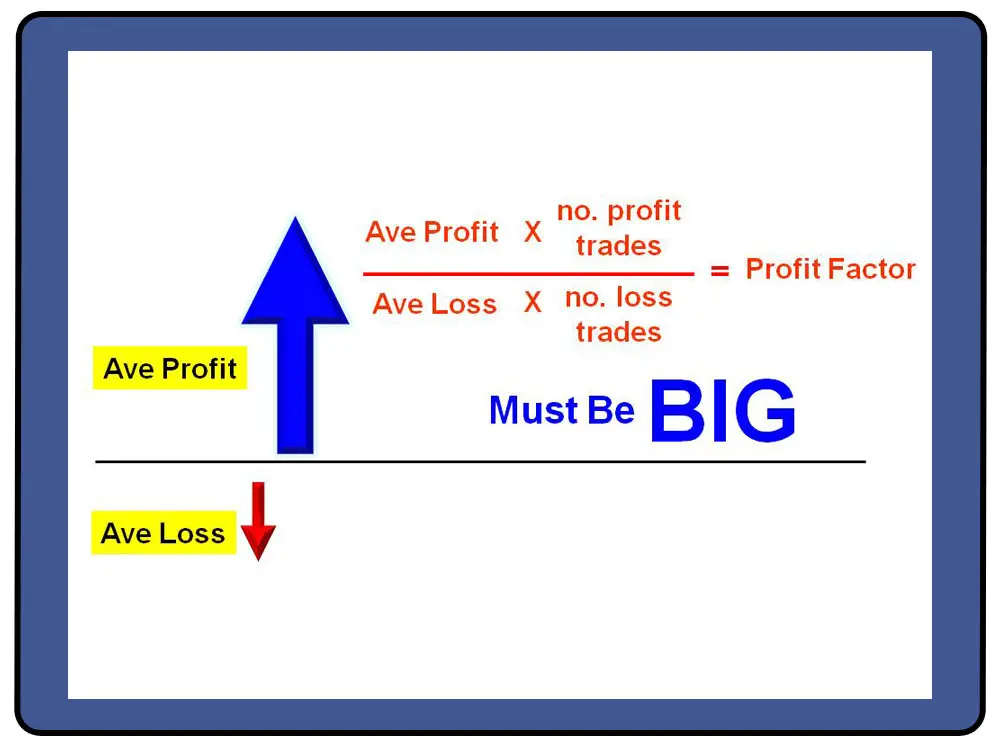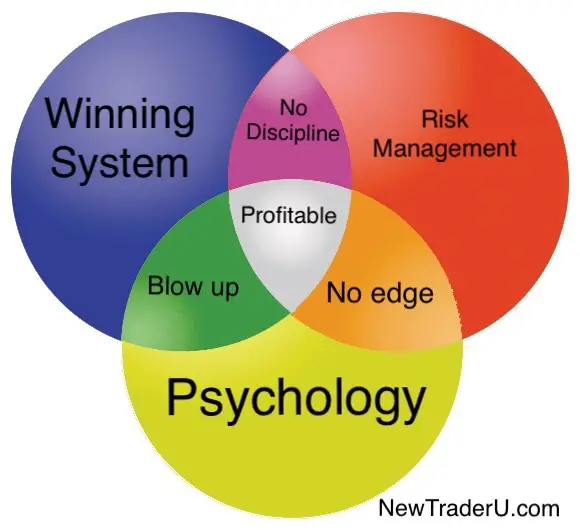Just like Stephen Covey found the effective habits of successful people through his studies I have found the common habits of successful traders through research. Many similarities for what creates success in any field. Let me breakdown the seven habits common in most successful traders.
1. Use A Positive Expectancy Model
What is Positive Expectancy?
The closest a trader can hope to come to a holy grail is a trading system with a positive expectancy. The first job of a trader is creating a quantified system with an edge that is repeatable and provides enough opportunities to be meaningful. A positive expectancy model creates more profits than losses that average out to profitability over time.
A positive expectancy means you have an edge, that when you average out all the wins and losses you make money. If you divide your total profits by your total trades you have a profit factor and have a positive outcome. A successful trader expects that if they place a certain amount of trades that they will be profitable at the end of the sequence of entries and exits based on their statistical and systematic edge.
As an example a casino, sports bookmaker, horse handicapper, professional gamblers, and Black Jack card counters all have an edge they understand that makes them profitable in the long-term as their edge plays out.
Positive expectancy could be the most important part of trading. For every trader no matter what trading method they use on any timeframe, if they don’t have a positive expectancy trading model then they have no edge and will likely have no long term profits. Most traders lose money because they have a negative expectancy model and don’t even know it. Risk/reward ratios, trade management, and backtesting are ways to define your expectancy.
Before traders start putting any money at risk they should know if the trading system they are using has a positive expectancy. Without first having a positive expectancy system to trade that fits your own risk tolerance and return goals your trading psychology and risk management don’t matter much. If you use good position sizing and the right mindset on trading a system with a negative expectancy or high risk of ruin it just means you lose money at a slower pace with a better attitude.
Knowing we have a positive expectancy means we have done enough homework, backtesting, and validation to show ourselves our trading system will create profits over the long term based on our signals, win rate, and risk/reward ratio.
The first part of successful trading is in the research to validate your system. This is a lot of work and effort and why most traders don’t succeed. Too many new traders enter the market in pursuit of easy and fast money not to do hundreds of hours of research.
A win rate is not what creates a positive expectancy it’s the size of all the wins and losses combined that create the expectancy. You can have a low win rate system that is profitable due to a few huge wins and a lot of small losses. Huge trading losses and large drawdowns due to bad position sizing are the primary factor that creates a negative expectancy system.
The first step to creating a positive expectancy system is removing big losses from your system and the second most important is to let your winners run. This is the purpose of your entry signals, exit signals, position sizing, trailing stops, and profit targets, to create a positive expectancy.
How can you calculate a trading system’s positive expectancy?
Positive Expectancy Formula:
E(R) = (PW x AW) – (PL x AL)
where:
E(R): Expectancy/ or Expected Return
PW: Probability of winning
AW: Average win
PL: Probability of losing
AL: Average loss
Positive Expectancy: is a positive “E(R)”
This is the first step in a new trader’s journey not something to do later. A lot of positive expectancy emerges from trade management after a trade entry with stops to minimize losses and trailing stops to maximize gains.
2. Use A Dynamic Trading Strategy
What is a dynamic trading strategy?
Trading dynamically, means reacting and adapting to what the market price action is telling you. It means following a plan created to maximize wins and minimize losses. It means managing a trade based on reactive technical analysis using entry signals, stop losses, trailing stops and profit targets.
No matter how much a trader believes that they can predict the future or how strong their conviction is, no individual trader or investor can control the outcome of a market move unless they have enough capital to move a market their self. Traders have the unique frustration that few other careers have, a lack of control on outcome. All a trader controls is their system development and execution, the market movement creates the outcome of wins and losses.
A trader can’t control:
- The price movement.
- The outcome of a trade.
Once a trader is in a trade the price movement is based on the collective actions of the market participants buying, selling, or holding not the trader’s predictions, hopes, and opinions. While a trader can manage a trade with size and exit strategies they can’t control whether their stop loss is triggered or their profit target is hit. A trader is at the mercy of the market to choose the outcome of each of their trades.
The good news is that a trader does have a lot of control.
A trader can control:
- When they enter a trade.
- When they don’t trade.
- A trader can choose their own watchlist.
- The price they exit to stop a loss.
- The price target they will exit at to lock in a gain.
- To use a trailing stop loss to let a winner run.
- The position sizing for a trade.
- Their plan to manage a maximum loss with the combination of position sizing and a stop loss.
- The technical indicators to use for signals.
- How their emotions are managed.
- The lessons they learn from every trade.
- Whether to keep trading or quit.
You can’t control what the market price action will do but you can control what you will do in response to the price action and how you manage each trade after entry. Before you’re in a trade you control how big and when you will get in. After you are in you control when and how you will get out. You will never control the markets but you can develop the discipline to have complete control of yourself. The dynamic of flexibility is a trait of most successful traders while stubbornness and arrogance is the factor that usually leads to ruin as opinions and trades become fixed.
3. Create Asymmetric Trades

The key to profitable trading is creating asymmetrical risk/reward ratios that are in your favor. Successful traders risk $100 to make $200 or more to create at least a 1:2 risk/reward ratio. This can be very profitable with just a 50% win rate.
For example:
Win $200
Win $200
Win $200
Lose $100
Lose $100
Lose $100
Total wins are $600 and total losses are $300 for a $300 profit in a six trade sequence. This is what successful trading looks like as a basic example.
Equal profit targets along with the same level as your stop would be considered symmetrical. You shouldn’t be buying a stock at $100, and your profit target be $103, with your stop at $97. This is symmetrical because it has the same dollar target on both sides of your trade. This means you have to win over half the time to be profitable. This is difficult for most traders, and a string of losses can be devastating to your account if you don’t have large winning trades to offset the drawdowns in capital.
Most traders do the worst thing they could by creating asymmetrical risk against their self. They take large position sizing going after small moves but will hold losing trades hoping to get back to even creating large losses. Risking a lot to make a little is the opposite of a favorable risk/reward ratio.
Successful traders limit their downside risk tightly with stop losses but leave their upside profit potential open with trailing stops and profit targets. This is what is meant by cutting losses short and letting winners run.
4. Mental Model Of Success
The way a successful trader thinks can be at the core of their profitability. Their operating mental model is faith in their system to create profits and faith in their self to execute it with discipline and focus. They don’t waste time and energy with self-doubt and second guessing their trading method. They trade, they learn, they adjust, and they grow. They bring passion and energy to their trading and have confidence in their self to navigate the markets and create profits using their system.
A successful trader knows who they are and are not doubleminded. They have no Plan B just the Plan A of becoming and staying a successful trader by doing whatever it takes. Their passion creates the energy they need to do the work to achieve success and then maintain their level of high performance.
Successful traders think very differently from the majority that never make it. At their core you will find positivity, passion, focus, and love for the game.
5. Experts On Their Method
Successful traders are experts on their chosen method, markets, and time frame. They know their edge and stay within their circle of competence. They don’t try to beat all traders just their direct competitors. They let the traders in other markets and time frames battle it out why they stay in their own lane.
They are not a Jack-of-all-trades, they are the masters of just one. It’s easier to win at a method you are an expert in than pursue things you don’t fully understand due to the fear of missing out on opportunities.
They choose a method to master and they build a system to optimize their own success. Many unsuccessful traders chase every waterfall but never learn how to swim.
You can only win battles after you choose which one to fight with focus and long-term effort in one direction.
6. Confluence of Profitable Dynamics
Successful traders have created a confluence of the three required parameters for profitable trading. Trading a winning system using the right risk management along with correct trading psychology.
If any of these three building blocks are missing then profitable trading will not be achieved.
If you have a winning system with proper risk management but the wrong trading psychology you will have no discipline to follow it.
If you have a winning system with the right trading psychology but no risk management you eventually will lose your account in ruin.
If you have the right trading psychology and good risk management but no winning system you will have no edge leading to profitability.
If you combine a positive expectancy model, with proper position sizing, and mental discipline then only time separates you from profitable trading. This is what successful traders learned on their journey.

7. Hunger To Win
“The secret to being successful from a trading perspective is to have an indefatigable and an undying and unquenchable thirst for information and knowledge.” – Paul Tudor Jones
The successful traders had the hunger and desire to win. Trading was the game they chose and much like the greatest professional athletes their edge came from wanting to win. Their desire drove them to doing the necessary work to achieve their goals.
They weren’t satisfied with trading as a hobby, they wanted to go pro and make it their full time job. Hunger to reach goals is the primary driver of the energy to get there.
The biggest determinant of successful traders from everyone else who didn’t make it through the learning curve was their hunger to succeed.
How bad do you want it?
